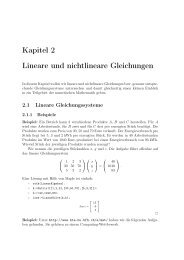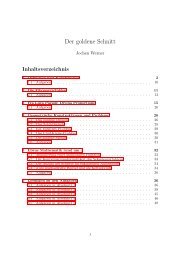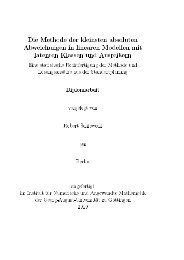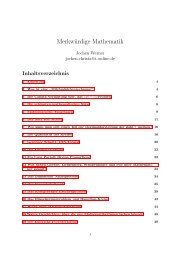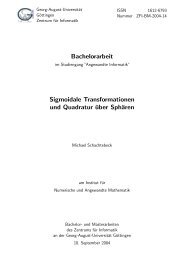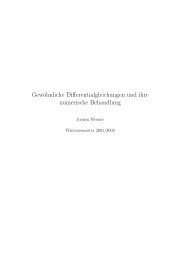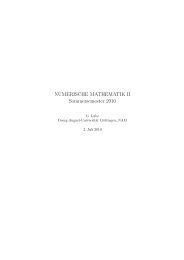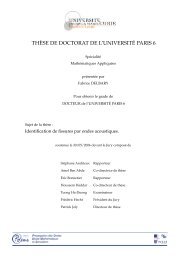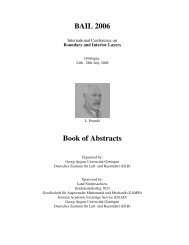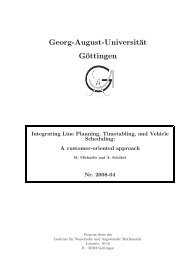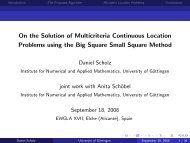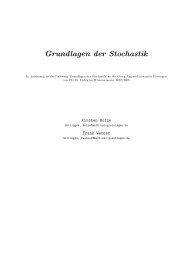Institut für Numerische und Angewandte Mathematik
Institut für Numerische und Angewandte Mathematik
Institut für Numerische und Angewandte Mathematik
You also want an ePaper? Increase the reach of your titles
YUMPU automatically turns print PDFs into web optimized ePapers that Google loves.
<strong>Institut</strong> <strong>für</strong> <strong>Numerische</strong> <strong>und</strong> <strong>Angewandte</strong> <strong>Mathematik</strong><br />
Disentangling exponential operators<br />
D. Scholz, V.G. Voronov, M. Weyrauch<br />
Nr. 2009-19<br />
Preprint-Serie des<br />
<strong>Institut</strong>s <strong>für</strong> <strong>Numerische</strong> <strong>und</strong> <strong>Angewandte</strong> <strong>Mathematik</strong><br />
Lotzestr. 16-18<br />
D - 37083 Göttingen
Disentangling exponential operators<br />
Daniel Scholz<br />
<strong>Institut</strong>e for Numerical and Applied Mathematics, Georg-August-University Göttingen, Germany<br />
dscholz@math.uni-goettingen.de<br />
Volodymyr G. Voronov<br />
Faculty of Physics, Taras Shevchenko National University of Kyiv, Ukraine<br />
v_voronov@univ.kiev.ua<br />
Michael Weyrauch<br />
Physikalisch-Technische B<strong>und</strong>esanstalt, Braunschweig, Germany<br />
michael.weyrauch@ptb.de<br />
Manuscript (Version of October 21, 2009)<br />
Abstract<br />
A new method for the approximate disentangling of exponential operators based on<br />
the Baker-Campbell-Haussdorff theorem is suggested and implemented in a computer<br />
program. The operators to be disentangled must form a finite-dimensional Lie algebra.<br />
The accuracy of the method is tested and demonstrated in several explicitly calculated<br />
examples, where exact analytic solutions are available.<br />
Keywords: Disentangling, Lie groups, Lie algebras, Baker-Campbell-Hausdorff series.<br />
PACS: 02.10.-v, 02.60.Pn<br />
1
1 Introduction<br />
The disentangling of exponential operators is a useful tool applied e.g. in quantum mechan-<br />
ics, quantum field theory, optics, or physical chemistry. Mathematically it may be regarded<br />
as a method for the solution of linear differential equations [1]. The basic idea has been<br />
developed long ago, e.g. by Feynman [2] and Glauber [3] and developed later into different<br />
directions by many authors, see e.g. Refs. [1, 4]. The method was reviewed recently by<br />
Popov [5].<br />
The formulation of the disentangling problem is particularly straightforward, if the oper-<br />
ators to be disentangled are members of a finite dimensional Lie algebra with generators<br />
{A1, . . . , Am}. Then, <strong>und</strong>er certain conditions discussed in more detail e.g. in Ref. [1], it<br />
holds that<br />
exp(ξ1A1 + . . . + ξmAm) = exp(σ1A1) · . . . · exp(σmAm), (1)<br />
with ξ1, . . . , ξm ∈ C given constants. Some of the ξi may be zero. The disentangling problem<br />
to be solved is the determination of the σ1, . . . , σm ∈ C for a given Lie algebra {A1, . . . , An}.<br />
Here, we will assume that for the Lie algebra <strong>und</strong>er consideration the relation (1) holds at<br />
least locally, and mathematical questions on the (global) existence of Eq. (1) will not be<br />
addressed [6]. The aim of the present paper is to suggest a new practical way for the<br />
approximate determination of the complex constants σ1, . . . , σm ∈ C and to provide a<br />
suitable computer implementation.<br />
There are various techniques which solve the disentanglement problem Eq. (1) for certain<br />
cases analytically and exactly. We briefly mention three of them: parameter differentiation,<br />
matrix representation of the Lie algebra, and a method using similarity transformations.<br />
Parameter differentiation was first used by Glauber [3] and exposed in detail by Wilcox [4]:<br />
First one introduces a parameter t into Eq. (1)<br />
exp(t(ξ1A1 + . . . + ξmAm)) = exp(σ1(t)A1) · . . . · exp(σm(t)Am)<br />
and then differentiates this equation with respect to t. Using the well known relation<br />
exp(A) · B · exp(−A) =<br />
∞�<br />
k=0<br />
1<br />
· {A, B}k<br />
(2)<br />
k!<br />
with the nested commutators {A, B}k = [A, {A, B}k−1] and {A, B}0 = B as well as the<br />
assumed Lie algebra structure in order to calculate the nested commutators finally leads<br />
to a system of ordinary differential equations. If this system can be solved analytically one<br />
2
may be able to obtain the solutions for σ1 to σm in closed form. Examples are discussed<br />
by Wilcox [4].<br />
A purely algebraic method based on a matrix representation of the Lie algebra may be useful<br />
if such a representation can be easily obtained. If the exponential of these matrices can<br />
be calculated in closed form one obtains a system of non-linear equations whose solutions<br />
yield the coefficients σ1 to σm. Examples from quantum optics are presented in Refs. [7, 8].<br />
A method already suggested by Wilcox [4] and exposed in more detail by DasGupta [9]<br />
compares similarity transformations induced by the left hand (entangled) side of Eq. (1)<br />
and the right hand (disentangled) side of Eq. (1) on the generators of the Lie algebra.<br />
Calculations make extensive use of Eq. (2) and lead to a system of non-linear equations<br />
in the unknown σ1 to σm. Note that if the identity operator I is a generator of the<br />
given Lie algebra, the similarity transformation method cannot compute the corresponding<br />
coefficient.<br />
The approximation method proposed here uses the Baker-Campbell-Haussdorff (BCH) the-<br />
orem [10, 11, 12] in order to rewrite the right hand side of Eq. (1). The BCH theorem asserts<br />
that the product of the exponentials of two non-commutative variables A and B may be<br />
expressed as the exponential of an infinite sum<br />
�<br />
exp(A) · exp(B) = exp<br />
A + B +<br />
∞�<br />
n=2<br />
Zn<br />
�<br />
, (3)<br />
where the BCH terms Zn may be expressed as linear combinations of nested commutators<br />
of the non-commuting variables A and B. If we truncate the sum in Eq. (3) at n = p we<br />
obtain an approximation for the product of two exponentials of order p.<br />
The BCH approximation for the disentangling of exponential operators is developed in<br />
detail in Section 2. A computer implementation is provided in Section 3 followed by a<br />
number of examples (Section 4) in order to demonstrate the accuracy of the method by<br />
comparison with known exact results. Conclusions in Section 5 summarize the paper.<br />
2 BCH approximation<br />
We assume that we are given a Lie algebra with generators A1, . . . , Am satisfying the com-<br />
mutation relations<br />
[Ai, Aj] = a ij<br />
1 · A1 + . . . + a ij m · Am = {a ij<br />
1 , . . . , aij m} (4)<br />
3
with the structure constants a ij m ∈ C for 1 ≤ i < j ≤ m. The component notation for a Lie<br />
element is implicitly introduced after the second equal sign in Eq. (4). It is now our goal to<br />
find an approximation for the coefficients σ1, . . . , σm in order to disentangle the exponential<br />
of a Lie element ξ = {ξ1, . . . , ξm},<br />
exp(ξ1A1 + . . . + ξmAm) = exp(σ1A1) · . . . · exp(σmAm). (5)<br />
The approximation is obtained as follows: We first use the Baker-Campbell-Hausdorff the-<br />
orem Eq. (3) up to order p repeatedly in order to combine all exponentials on the right<br />
hand side of Eq. (5). Then, using the structure of the Lie algebra Eq. (4), it is possible to<br />
evaluate the nested commutators in the resulting exponential, and, in principle, write the<br />
right hand side of Eq. (5) in the form<br />
�<br />
exp(σ1A1) · . . . · exp(σmAm) ≈ exp f p<br />
1 (σ1, . . . , σm) · A1 + . . . + f p �<br />
m(σ1, . . . , σm) · Am<br />
where f p<br />
1 , . . . , f p m : C m → C are functions which depend on the order p of the BCH approx-<br />
imation.<br />
In order to obtain an approximation for the σi one finally needs to solve the system of<br />
non-linear equations<br />
⎛<br />
f p<br />
1 (τ1, . . . , τm)<br />
F p (τ1, . . . , τm) =<br />
⎜<br />
⎝<br />
.<br />
f p m(τ1, . . . , τm)<br />
⎟<br />
⎠ =<br />
⎞<br />
⎛<br />
⎜<br />
⎝<br />
ξ1<br />
.<br />
ξm<br />
⎞<br />
⎟ . (6)<br />
⎠<br />
Let (τ1, . . . , τm) be a solution of this system. We then obtain the approximation σk ≈ τk<br />
for k = 1, . . . , m. Note that the functions f p<br />
k (τ1, . . . , τm) for k = 1, . . . , m are polynomials<br />
of degree p − 1.<br />
While the procedure outlined above is conceptually straightforward, a practical implemen-<br />
tation requires a few tools, which were partly developed recently [13]. First we need a way<br />
to determine the BCH terms to the desired order. A polynomial representation of the BCH<br />
terms Zn defined in Eq. (3) is given by<br />
Zn = �<br />
t1,u1,...,tn,un<br />
Λn(A t1 B u1 . . . A tn B un ) · A t1 B u1 . . . A tn B un<br />
where the sum is over all t1, u1, . . . , tn, un ∈ {0, 1} with tk + uk = 1 for k = 1, . . . , n. It<br />
holds that Λ1(A) = Λ1(B) = 1 and Λn(A t1 B u1 . . . A tn B un ) ∈ Q. E.g., for Z3 one obtains<br />
Z3 = 1<br />
12<br />
1 1 1<br />
AAB − ABA + ABB +<br />
6 12 12<br />
4<br />
1 1<br />
BAA − BAB +<br />
6 12 BBA,
and, therefore, e.g. Λ3(ABB) = 1/12.<br />
In order to make use of the Lie algebra structure assumed above the polynomial repre-<br />
sentation of the BCH terms must be converted into a representation in terms of nested<br />
commutators. Such a representation is known to exist, but it is not unique. A suitable map<br />
from polynomials to nested commutators was first developed by Dynkin [14, 15]. Later a<br />
map Φ which yields fewer terms than the Dynkin map was conjectured by Oteo [16], and<br />
we recently proved that this map is valid [13].<br />
The map Φ is defined as follows: For general polynomials<br />
where Λ s n ∈ Q and X s i<br />
Φ(P (A, B)) =<br />
P (A, B) =<br />
m�<br />
s=1<br />
Λ s n · X s 1 . . . X s n<br />
∈ {A, B} for i = 1, . . . , n and s = 1, . . . , m, define<br />
m�<br />
s=1<br />
X s 1 =A, Xs 2 =B<br />
Λ s n<br />
N(X s 1 , . . . , Xs n) · [[· · · [[[A, B], Xs 3], X s 4], . . .], X s n].<br />
Here, N(X s 1 , . . . , Xs n) is the number of A generators in the set {X s 1 , . . . , Xs n}, e.g. N(ABAAB) = 3.<br />
We proved in Ref. [13] the following theorem:<br />
For all n ≥ 2 it holds that Φ(Zn) = Zn.<br />
E.g., for Z3 one obtains<br />
Z3 = 1<br />
12<br />
1 1 1<br />
AAB − ABA + ABB +<br />
6 12 12<br />
= − 1<br />
1<br />
[[A, B], A] + [[A, B], B] = Φ(Z3).<br />
12 12<br />
1 1<br />
BAA − BAB +<br />
6 12 BBA<br />
With the tools collected above it is possible to explicitly calculate the function F p in Eq. (6)<br />
to the desired order p with the help of a computer.<br />
Finally, we need a suitable method to solve the system of non-linear equations given in<br />
Eq. (6). In general, there are several solutions of such a polynomial system, and we need<br />
to pick out that solution which for fixed i and ξ → ei = (0, . . . , 0, 1, 0, . . . , 0) continuously<br />
evolves into (σ1, . . . , σm) = ei, which must hold according to Eq. (5).<br />
Numerically, we semi-continuously evolve the desired solution from the trivial solution for<br />
ξ = e1 by solving several auxiliary problems<br />
F p (τ) = t · ξ + (1 − t) · e1 for t = 1 2<br />
,<br />
M M<br />
5<br />
M − 1<br />
, . . . , , 1,<br />
M
where the parameter t controls the ‘distance’ of the auxiliary problem to the problem we<br />
want to solve (t = 1). The parameter M defines the number of auxiliary problems to be<br />
considered.<br />
For each step in this procedure, we solve the non-linear system of equations (6) using<br />
Newton’s iteration method<br />
τ k+1 = τ k �<br />
− DF (τ k �−1 ) · (F (τ k ) − ξ)<br />
with the Jacobian DF p (τ1, . . . , τm) of F p (τ1, . . . , τm) given by<br />
DF p (τ1, . . . , τm) =<br />
⎛<br />
⎜<br />
⎝<br />
∂f p<br />
1<br />
∂τ1 (τ1, . . . , τm) . . .<br />
.<br />
∂f p m<br />
∂τ1 (τ1, . . . , τm) . . .<br />
∂f p<br />
1<br />
∂τm (τ1, . . . , τm)<br />
.<br />
∂f p m<br />
∂τm (τ1, . . . , τm)<br />
As the starting vector τ 0 for each Newton iteration we use the solution of the previous step<br />
starting with τ 0 = e1 for t = 1<br />
M . Summarizing, we suggest the following solution approach:<br />
Input: Absolute accuracy ε > 0 and number of steps M ∈ N.<br />
( 1 ) Set τ := e1, ˆτ := e1, k := 0, and t := 0.<br />
( 2 ) If k = M, stop. Else set k = k + 1 and t = k/M.<br />
( 3 ) Set τ = ˆτ and<br />
� �−1 �<br />
�<br />
ˆτ = τ − DF (τ) · F (τ) − (t · ξ + (1 − t) · e1) .<br />
( 4 ) If �τ − ˆτ�2 < ε, go to Step ( 2 ). Else go to Step ( 3 ).<br />
Output: Approximation ˆτ.<br />
In all examples in Section 4 we applied this technique using ε = 10 −10 and M = 10.<br />
3 Computer implementation<br />
In this section we provide a Mathematica 7 [17] implementation of the BCH approximation<br />
method outlined in the previous section. Of course, similar implementations are easily<br />
possible in other languages.<br />
6<br />
⎞<br />
⎟<br />
⎠ .
The implementation assumes that the commutation relations of the Lie algebra are coded<br />
as K[i,j]={a_1^{ij},...,a_m^{ij}} for all 1 ≤ i < j ≤ m. For example, for the SU(1,1)<br />
algebra with generators {K+, K0, K−}, which is defined by the commutation relations<br />
[K+, K0] = −K+ [K0, K−] = −2K0 [K0, K−] = −K−,<br />
one needs to enter the following Mathematica statements:<br />
K[1,2] = {-1,0,0};<br />
K[1,3] = {0,-2,0};<br />
K[2,3] = {0,0,-1};<br />
The commutator of two Lie elements a and b is then calculated by the following function:<br />
cm[a_List,b_List]:=Module[{range,vor,com},<br />
range = Range[Length[a]];<br />
vor = Times @@@ Flatten[Outer[List,a,b], 1];<br />
com = K @@@ Flatten[Outer[List,range,range], 1];<br />
vor.com];<br />
Using again the SU(1,1) algebra as an example, the Lie element 2K0 + K− is coded by<br />
{0,2,1} and the Lie element K+ +K− is coded by {1,0,1}. Hence, we obtain for example:<br />
cm[{0,2,1},{1,0,1}] = 2*K[2,1]+2*K[2,3]+K[3,1]+K[3,3] = {2,2,-2}<br />
Nested commutators are computed by the code:<br />
nestcm[a_List,b_List]:=Module[{oplist},<br />
oplist = Flatten[Table @@@ Partition[Riffle[Partition[a,1], b, {1,-2,2}],2], 1];<br />
Fold[cm, First[oplist], Rest[oplist]] ];<br />
We compute the BCH terms up to approximation order p using Goldberg’s method [18]. A<br />
slightly different variant of the code below is discussed and documented in more detail in<br />
Ref. [13].<br />
G[1] = 1;<br />
G[s_]:= G[s] =Expand[1/s*D[t*(t-1)*G[s-1],t]];<br />
GC[W_List] := GC[W] =Module[{m,m1,m2,k},<br />
m = Length[W];<br />
m1 = Floor[m/2];<br />
m2 = Floor[(m-1)/2];<br />
Integrate[t^m1*(t-1)^m2*Product[G[W[[k]]],{k, m}], {t,0,1}]];<br />
Goldberg[n_,l_List] := Module[{L},<br />
L = Select[Flatten[Permutations /@ IntegerPartitions[n], 1], First[#] == 1 &];<br />
Plus @@ ((GC[Sort[#]]/(Plus @@ First /@ Partition[#,2,2,1,{}])*nestcm @@ {#,l}) & /@ L)];<br />
BCH[n_Integer] := BCH[n] = Plus @@ {f,g} + Sum[Goldberg[k, {f,g}], {k,2,n}];<br />
7
BCH[p] returns all BCH terms up to the order of p in a commutator representation for<br />
non-commutating variables f and g. Here, unlike in Ref. [13], we directly applied the map<br />
Φ as defined in the previous section.<br />
The set of non-linear equations (6) is set up and solved using the command sigmas. The<br />
non-commuting variables f and g in the BCH terms are replaced by the appropriate Lie<br />
elements:<br />
sigmas[n_Integer,xi_List,eps_Rational,M_Integer] :=<br />
Module[{sm,m,s,F,DF,k,tau,tau1,tau2,t},<br />
sm = DiagonalMatrix[Table[s[i], {i,m=Length[xi]}]];<br />
tau = tau1 = UnitVector[m,1];<br />
K[x_Integer, y_Integer] := -K[y, x] /; x > y;<br />
K[x_Integer, y_Integer] := Table[0, {m}] /; (x == y);<br />
F = Expand[Fold[BCH[n] /. {f -> #1, g -> #2} &, sm[[1]], Rest[sm]]];<br />
DF = Table[D[F[[i]],s[j]], {i,m}, {j,m}];<br />
For[k = 1, k #[[j]]].((F /. s[j_] :> #[[j]])<br />
- (t*xi+(1-t)*tau1)) &, tau, Norm[#1-#2] >= eps &, 2]];<br />
tau2<br />
];<br />
The variable F holds the function F p (σ1, . . . , σm) and the rest of the code implements<br />
Newton’s iteration method as described in the previous section.<br />
Thus, the function sigmas[p,xi,epsilon,M] returns the desired approximation for the<br />
coefficients σ1 to σm. Here, p is the BCH approximation order, xi is the vector ξ =<br />
(ξ1, . . . , ξm) as given in Eq. (1), and epsilon and M are the parameters ε and M, which<br />
control Newton’s iteration method as described in the previous section.<br />
4 Examples<br />
In order to study the applicability of our implementation of the BCH approximation for<br />
the disentangling of exponential operators we here present a few numerical examples. For<br />
all examples analytical results are available for comparison.<br />
4.1 Two-dimensional Lie algebra<br />
Consider the Lie algebra {A, B} with [A, B] = λB and λ ∈ C. We look for σ1, σ2 ∈ C<br />
such that<br />
exp(αA + βB) ≈ exp(σ1A) · exp(σ2B).<br />
8
As shown e.g. in Ref. [9] by the similarity transformation method mentioned in the intro-<br />
duction, it holds that<br />
σ1 = α and σ2 = β<br />
λα · (1 − e−λα ).<br />
Using the BCH approximation up to order p = 4 one finds<br />
exp(σ1A) · exp(σ2B) ≈<br />
�<br />
exp σ1A + σ2B + 1<br />
2 σ1σ2λB + 1<br />
12 σ2 1σ2λ 2 =<br />
�<br />
B<br />
�<br />
�<br />
exp σ1 · A + σ2 1 + 1<br />
2 σ1λ + 1<br />
12 σ2 1λ 2<br />
� �<br />
· B .<br />
Hence, we obtain<br />
F 4 (τ1, τ2) =<br />
⎛<br />
⎝<br />
and the solution of this system is<br />
τ1<br />
�<br />
1<br />
τ2 1 + 2τ1λ + 1<br />
12τ 2 1 λ2�<br />
τ1 = α and τ2 =<br />
⎞<br />
⎠ =<br />
β<br />
⎛<br />
⎝ α<br />
β<br />
1 + 1 1<br />
2αλ + 12α2 . (7)<br />
λ2 Table 1 presents numerical results for different approximation orders p and selected values<br />
for α, β, and λ.<br />
p {α, β, λ} {�τ1 − σ1�, �τ2 − σ2�}<br />
4 {1, 1, 1} {0, 5.41 · 10 −4 }<br />
8 {1, 1, 1} {0, 3.22 · 10 −7 }<br />
12 {1, 1, 1} {0, 2.06 · 10 −10 }<br />
4 {1 + i, 1 − i, 1} {0, 2.90 · 10 −3 }<br />
8 {1 + i, 1 − i, 1} {0, 6.89 · 10 −6 }<br />
12 {1 + i, 1 − i, 1} {0, 1.76 · 10 −8 }<br />
4 { 1<br />
2 , 1 − i, 2} {0, 7.65 · 10−4 }<br />
8 { 1<br />
2 , 1 − i, 2} {0, 4.56 · 10−7 }<br />
12 { 1<br />
2 , 1 − i, 2} {0, 2.91 · 10−10 }<br />
Table 1: Disentangling coefficients for the Lie algebra {A, B} with [A, B] = λB.<br />
For the present example it is furthermore possible to address questions of convergence:<br />
Obviously, the denominator in Eq. (7) results from the expansion,<br />
x<br />
1 − exp(−x) =<br />
∞�<br />
(−)<br />
n=0<br />
n Bnx n<br />
n!<br />
⎞<br />
⎠<br />
1 1<br />
= 1 + x +<br />
2 12 x2 + 1<br />
180 x3 + . . .<br />
which is a relation well known from one possible definition of the Bernoulli numbers Bn. It<br />
is known that this series converges for 0 < |x| < 2π, which in this case defines the radius<br />
9
of convergence for our method to work. Specifically, it must hold that 0 < |αλ| < 2π. In<br />
Figure 1, we show numerical results for α = β = 1 and 0 ≤ λ ≤ 10. The exact solution<br />
for σ2 = σ2(λ) corresponds to the thin black curve and the BCH approximation for orders<br />
p = 4, p = 9, and p = 12 are illustrated by the dotted, dashed, and solid curves, respectively.<br />
It can be seen that one cannot expect convergence for values λ ≥ 2π.<br />
Figure 1: (Color online) Disentangling coefficient σ2 for the two-dimensional Lie algebra<br />
{A, B} for 0 ≤ λ ≤ 10. Exact solution (thin black curve), approximation order p = 4<br />
(dotted green curve), approximation order p = 9 (dashed blue curve), and approximation<br />
order p = 12 (solid red curve).<br />
4.2 Four-dimensional Lie algebra<br />
In our second example we consider the Lie algebra {A, B, D, I} with the commutation<br />
relations<br />
[A, B] = −λD [A, D] = −µB [A, I] = 0<br />
[B, D] = −αI [B, I] = 0 [D, I] = 0<br />
for λ, µ, α ∈ C. Our goal is to approximate the coefficients σ1, . . . , σ4 ∈ C such that<br />
exp(A + B) ≈ exp(σ1A) · exp(σ2B) · exp(σ3D) · exp(σ4I).<br />
Exact solutions are e.g. given in Ref. [19]<br />
σ1 = 1, σ2 = sinh(√ λµ)<br />
√ λµ<br />
, σ3 = cosh(√λµ) − 1<br />
, σ4 =<br />
µ<br />
α<br />
4µ ·<br />
10<br />
� sinh(2 √ λµ)<br />
√ λµ<br />
�<br />
− 2 .
The BCH approximation up to order p = 4 yields the system of equations<br />
F 4 ⎛<br />
(τ1, τ2, τ3, τ4) =<br />
⎜<br />
⎝<br />
τ1<br />
τ2 − 1<br />
2τ1τ3µ + 1<br />
12τ 2 1 τ2λµ<br />
τ3 − 1<br />
2τ1τ2λ + 1<br />
12τ1τ3µλ ⎞ ⎛ ⎞<br />
⎟<br />
⎠<br />
=<br />
1<br />
⎜ ⎟<br />
⎜ ⎟<br />
⎜ 1 ⎟<br />
⎜ ⎟<br />
⎜ ⎟ .<br />
⎜ 0 ⎟<br />
⎝ ⎠<br />
0<br />
τ4 − 1<br />
2τ2τ3α − 1<br />
12τ1τ 2 1<br />
2 λα + 12τ1τ 2 3 µα<br />
Numerical comparison between the exact solution and the BCH approximation can be fo<strong>und</strong><br />
in Table 2.<br />
p {λ, µ, α} {�τ1 − σ1�, . . . , �τ4 − σ4�}<br />
4 {1, 1, 1} {0, 2.27 · 10 −3 , 1.73 · 10 −3 , 9.96 · 10 −4 }<br />
8 {1, 1, 1} {0, 1.35 · 10 −6 , 1.03 · 10 −6 , 2.34 · 10 −6 }<br />
12 {1, 1, 1} {0, 8.64 · 10 −10 , 6.58 · 10 −10 , 2.62 · 10 −9 }<br />
4 {1 − i 1<br />
2 , 2 + i, 2} {0, 3.64 · 10−3 , 3.03 · 10−3 , 6.60 · 10−3 }<br />
8 {1 − i 1<br />
2 , 2 + i, 2} {0, 3.38 · 10−6 , 2.82 · 10−6 , 1.23 · 10−5 }<br />
12 {1 − i 1<br />
2 , 2 + i, 2} {0, 3.37 · 10−9 , 2.81 · 10−9 , 1.95 · 10−8 }<br />
4 {2, i<br />
2 , −1} {0, 1.50 · 10−3 , 2.80 · 10 −3 , 6.96 · 10 −3 }<br />
8 {2, i<br />
2 , −1} {0, 8.93 · 10−7 , 1.66 · 10 −6 , 7.36 · 10 −6 }<br />
12 {2, i<br />
2 , −1} {0, 5.71 · 10−10 , 1.06 · 10 −9 , 6.76 · 10 −9 }<br />
Table 2: Disentangling coefficients for the four-dimensional Lie algebra.<br />
4.3 SU(1,1) algebra<br />
Here and in the following examples we will use the same notations as given in Refs. [7, 9].<br />
The SU(1,1) Lie algebra {K+, K0, K−} satisfies the commutation relations<br />
[K+, K0] = −K+ [K+, K−] = −2K0 [K0, K−] = −K−.<br />
For complex parameters α denote by α ∗ the conjugate of α. Our aim is to approximate the<br />
disentanglement coefficients σ1 to σ3 in<br />
exp(αK+ − α ∗ K−) = exp(σ1K+) · exp(σ2K0) · exp(σ3K−).<br />
Rewriting α = λ · e iθ with λ ≥ 0 and 0 ≤ θ < 2π, the exact solutions [7] are given by<br />
σ1 = e iθ · tanh(λ), σ2 = − 2 log(cosh(λ)), σ3 = − e −iθ · tanh(λ).<br />
Table 3 presents numerical results of the disentanglement coefficients using the BCH ap-<br />
proximation.<br />
11
4.4 SU(2) algebra<br />
p α {�τ1 − σ1�, . . . , �τ3 − σ3�}<br />
4 1 {1.28 · 10 −2 , 3.72 · 10 −2 , 6.70 · 10 −3 }<br />
8 1 {4.89 · 10 −4 , 1.40 · 10 −3 , 2.81 · 10 −4 }<br />
12 1 {2.19 · 10 −5 , 6.31 · 10 −5 , 1.29 · 10 −5 }<br />
4 1 + i<br />
2<br />
8 1 + i<br />
2<br />
12 1 + i<br />
2<br />
{1.91 · 10 −2 , 6.63 · 10 −2 , 7.39 · 10 −3 }<br />
{1.07 · 10 −3 , 3.64 · 10 −3 , 4.96 · 10 −4 }<br />
{7.23 · 10 −5 , 2.48 · 10 −4 , 3.48 · 10 −5 }<br />
4 1<br />
2 + i {1.91 · 10−2 , 6.63 · 10 −2 , 7.39 · 10 −3 }<br />
8 1<br />
2 + i {1.07 · 10−3 , 3.64 · 10 −3 , 4.96 · 10 −4 }<br />
12 1<br />
2 + i {7.23 · 10−5 , 2.48 · 10 −4 , 3.48 · 10 −5 }<br />
Table 3: Disentangling coefficients for the SU(1,1) algebra.<br />
The SU(2) Lie algebra has three generators {J+, J0, J−} which satisfy the commutation<br />
relations<br />
[J+, J0] = −J0 [J+, J−] = 2J0 [J0, J−] = −J−.<br />
Here, we want to calculate the disentanglement<br />
exp(αJ+ − α ∗ J−) = exp(σ1J+) · exp(σ2J0) · exp(σ3J−).<br />
Rewriting again α = λ · e iθ , the exact solutions as derived in Refs. [7, 9] are<br />
σ1 = e iθ · tan(λ), σ2 = 2 log(sec(λ)), σ3 = − e −iθ · tan(λ).<br />
Numerical results can be fo<strong>und</strong> in Table 4.<br />
Moreover, Figure 2 presents some results for α ∈ R and 0 ≤ α ≤ 1.5. The exact solutions<br />
σ1 = σ1(α) to σ3 = σ3(α) correspond to the thin black curves and the BCH approximation<br />
for orders p = 3, p = 7, and p = 11 are illustrated by dotted, dashed, and solid curves,<br />
respectively.<br />
4.5 The six-dimensional double photon algebra<br />
In our last example we turn to the double photon algebra {K+, A + , K0, I, K−, A}, defined<br />
by the following commutation relations:<br />
12
p α {�τ1 − σ1�, . . . , �τ3 − σ3�}<br />
4 1 {5.14 · 10 −2 , 9.13 · 10 −2 , 9.55 · 10 −2 }<br />
8 1 {1.19 · 10 −2 , 1.23 · 10 −2 , 1.51 · 10 −2 }<br />
12 1 {7.38 · 10 −4 , 7.54 · 10 −4 , 9.22 · 10 −4 }<br />
4 1 + i<br />
2<br />
8 1 + i<br />
2<br />
12 1 + i<br />
2<br />
{8.52 · 10 −1 , 8.25 · 10 −1 , 1.17 · 10 −0 }<br />
{7.99 · 10 −2 , 7.12 · 10 −2 , 1.03 · 10 −1 }<br />
{7.14 · 10 −3 , 6.36 · 10 −3 , 9.04 · 10 −3 }<br />
4 1<br />
2 + i {8.53 · 10−1 , 8.25 · 10 −1 , 1.17 · 10 −0 }<br />
8 1<br />
2 + i {7.99 · 10−2 , 7.12 · 10 −2 , 1.03 · 10 −1 }<br />
12 1<br />
2 + i {7.14 · 10−3 , 6.36 · 10 −3 , 9.04 · 10 −3 }<br />
Table 4: Disentangling coefficients for the SU(2) algebra.<br />
Figure 2: (Color online) Numerical results for the SU(2) algebra for 0 ≤ α ≤ 1.5. Exact so-<br />
lutions (thin black curves), approximation order p = 3 (dotted green curves), approximation<br />
order p = 7 (dashed blue curves), and approximation order p = 11 (solid red curves).<br />
13
[K+, A + ] = 0 [K+, K0] = −K+ [K+, I] = 0<br />
[K+, K−] = −2K0 [K+, A] = −A + [A + , K0] = − 1<br />
2 A+<br />
[A + , I] = 0 [A + , K−] = −A [A + , A] = −I<br />
[K0, I] = 0 [K0, K−] = −K− [K0, A] = − 1<br />
2 A<br />
[I, K−] = 0 [I, A] = 0 [K−, A] = 0.<br />
With α = λ · e iθ and ζ = µ · e iφ , our goal is to approximate the disentanglement form<br />
exp(αK+ + ζA + − α ∗ K− − ζ ∗ A)<br />
= exp(σ1K+) · exp(σ2A + ) · exp(σ3K0) · exp(σ4I) · exp(σ5K−) · exp(σ6A).<br />
The exact coefficients as given in Ref. [9] are<br />
σ1 = e iθ · tanh(λ),<br />
µ<br />
σ2 = −<br />
λ cosh(λ) ·<br />
σ3 = −2 log(cosh(λ)),<br />
µ<br />
σ4 = −<br />
2<br />
λ2 cosh(λ) ·<br />
σ5 = −e −iθ · tanh(λ),<br />
µ<br />
σ6 = −<br />
λ cosh(λ) ·<br />
�<br />
(cosh(λ) − 1) · e i(θ−φ) − sinh(λ) · e iφ�<br />
,<br />
�<br />
�<br />
(cosh(λ) − 1) + i sin(θ − 2φ) · (sinh(λ) − λ cosh(λ)) ,<br />
�<br />
(cosh(λ) − 1) · e −i(θ−φ) + sinh(λ) · e −iφ�<br />
.<br />
We believe that the result for σ6 given in Ref. [9] has a misprint for the sign before the sinh<br />
term. Finally, results using the BCH approximation are presented in Table 5.<br />
p {α, ζ} {�τ1 − σ1�, . . . , �τ6 − σ6�}<br />
4 {1, 1} {1.28 · 10 −2 , 6.86 · 10 −3 , 3.72 · 10 −2 , 1.86 · 10 −3 , 6.71 · 10 −3 , 7.00 · 10 −3 }<br />
8 {1, 1} {4.89 · 10 −4 , 2.44 · 10 −4 , 1.40 · 10 −3 , 6.04 · 10 −5 , 2.81 · 10 −4 , 2.84 · 10 −4 }<br />
12 {1, 1} {2.19 · 10 −5 , 1.11 · 10 −5 , 6.31 · 10 −5 , 2.92 · 10 −6 , 1.29 · 10 −5 , 1.25 · 10 −5 }<br />
4 {1 + i 1<br />
2 , 2 + i} {1.91 · 10−2 , 2.03 · 10−2 , 6.63 · 10−2 , 1.43 · 10−2 , 7.39 · 10−3 , 3.04 · 10−2 }<br />
8 {1 + i 1<br />
2 , 2 + i} {1.07 · 10−3 , 1.16 · 10−3 , 3.64 · 10−3 , 6.81 · 10−4 , 4.96 · 10−4 , 1.54 · 10−3 }<br />
12 {1 + i 1<br />
2 , 2 + i} {7.23 · 10−5 , 7.93 · 10−5 , 2.46 · 10−4 , 4.62 · 10−5 , 3.48 · 10−5 , 1.02 · 10−4 }<br />
4 { 1<br />
2<br />
8 { 1<br />
2<br />
12 { 1<br />
2<br />
3i 1 2i<br />
+ 7 , − 2 + 3 } {2.54 · 10−3 , 3.94 · 10−3 , 4.00 · 10−3 , 3.15 · 10−3 , 2.05 · 10−3 , 3.22 · 10−3 }<br />
+ 3i<br />
7<br />
+ 3i<br />
7<br />
, − 1<br />
2<br />
, − 1<br />
2<br />
+ 2i<br />
3 } {2.07 · 10−5 , 3.28 · 10 −5 , 3.28 · 10 −5 , 2.64 · 10 −5 , 1.71 · 10 −5 , 2.40 · 10 −5 }<br />
+ 2i<br />
3 } {1.91 · 10−7 , 3.03 · 10 −7 , 3.02 · 10 −7 , 2.44 · 10 −7 , 1.58 · 10 −7 , 2.16 · 10 −7 }<br />
Table 5: Disentangling coefficients for the double photon algebra.<br />
14
5 Conclusion<br />
In this paper we suggested a general method for the approximate disentangling of expo-<br />
nential operators which satisfy a finite dimensional Lie algebra. We provide a computer<br />
implementation which determines the disentangling coefficients σ as defined in Eq. (1) for, in<br />
principle, arbitrary Lie algebras. The method uses the Baker-Campbell-Haussdorff theorem<br />
in an essential way, and therefore we expect that it converges only in a finite convergence<br />
radius centered at zero for all parameters of a given problem. The limits of convergence<br />
have not been investigated in detail.<br />
The computer implementation is a basic demonstration of the method, but does not control<br />
accuracy by e.g. comparing different approximation orders. Accuracy control could easily<br />
be added in a more sophisticated version of the implementation. Furthermore, the code is<br />
optimized for simplicity, but not for running time.<br />
Five numerical examples with known exact analytic solutions demonstrate that the method<br />
yields very good approximations for various parameter sets. For example, we obtained<br />
a quite good approximation using the four-dimensional Lie algebra as defined in Subsec-<br />
tion 4.2 already for an approximation order p = 8. For the three-dimensional SU(2) algebra,<br />
the same accuracy was achieved for an order of p ≥ 14.<br />
As explained in the text we need to smoothly evolve the solution for a given problem from a<br />
trivial initial auxiliary problem in a number of steps. The number of auxiliary problems to<br />
be considered is controlled by the parameter M for Newton’s iteration procedure. Although<br />
we used M = 10 in all numerical examples, there might be problems for which Newton’s<br />
method only picks the correct solution for some larger values of M. This would need to be<br />
carefully controlled by suitable tests.<br />
References<br />
[1] J. Wei and E. Norman. Lie algebraic solution of linear differential equations. J. Math.<br />
Phys., 4:575–581, 1963.<br />
[2] R.P. Feynman. An operator calculus having applications in quantum electrodynamics.<br />
Phys. Rev., 84:108–128, 1951.<br />
[3] R.J. Glauber. Some notes on multiple-Boson processes. Phys. Rev., 84:395–400, 1951.<br />
15
[4] R.M. Wilcox. Exponential operators and parameter differentiation in quantum physics.<br />
J. Math. Phys., 8:962–982, 1967.<br />
[5] V.S. Popov. Feynman disentangling of noncommuting operators and group represen-<br />
tation theory. Phys. Usp., 50:1217–1238, 2007.<br />
[6] M. Suzuki. On the convergence of exponential operators – the Zassenhaus formula,<br />
BCH formula and systematic approximants. Commun. Math. Phys., 57:193–200, 1977.<br />
[7] A. Mufti, H.A. Schmitt, and M. Sargent III. Finite-dimensional matrix representations<br />
as calculational tools in quantum optics. Am. J. Phys., 61:729–733, 1993.<br />
[8] R. Barak and Y. Ben-Aryeh. Photon statistics and entanglement in coherent-squeezed<br />
linear Mach-Zehnder and Michelson interferometers. J. Opt. Soc. Am. B, 25:361–372,<br />
2008.<br />
[9] A. DasGupta. Disentanglement formulas: An alternative derivation and some appli-<br />
cations to squeezed coherent states. Am. J. Phys., 64:1422–1427, 1996.<br />
[10] H.F. Baker. Alternants and continuous groups. Proc. London Math. Soc., s2-3:24–47,<br />
1905.<br />
[11] J.E. Campbell. On a law of combination of operators. Proc. London Math. Soc.,<br />
s1-29:14–32, 1897.<br />
[12] F. Hausdorff. Die symbolische Exponentialformel in der Gruppentheorie. Ber. Verh.<br />
Saechs. Akad. Wiss., Leipzig, Math.-Phys. Kl., 58:19–48, 1906.<br />
[13] M. Weyrauch and D. Scholz. Computing the Baker-Campbell-Hausdorff series and the<br />
Zassenhaus product. Comp. Phys. Commun., 180:1558–1565, 2009.<br />
[14] E.B. Dynkin. On the representation by means of commutators of the series log e x e y<br />
for noncommuting x, y. MSb25, 67:155–162, 1949. In Russian.<br />
[15] E.B. Dynkin. Calculation of the coefficients in the Campbell-Hausdorff formula. Dokl.<br />
Akad. Nauk. SSSR, 57:323–326, 1947. In Russian. An English translation may be fo<strong>und</strong><br />
in “Selected papers of E.B. Dynkin with commentary”, E.B. Dynkin, A.A. Yushkevich,<br />
G.M. Seitz, A.L. Onishchik, editors. American Mathematical Society, Providence, R.I.,<br />
and International Press, Cambridge, Mass., 2000.<br />
[16] J.A. Oteo. The Baker-Campbell-Hausdorff formula and nested commutator identities.<br />
J. Math. Phys., 32:419–424, 1991.<br />
16
[17] Wolfram Research, Inc. Mathematica Edition: Version 7. Wolfram Research, Inc.,<br />
2009.<br />
[18] K. Goldberg. The formal power series for log e x e y . Duke Math. J., 23:13–21, 1956.<br />
[19] M. Toutounji. Algebraic approach to electronic spectroscopy and dynamics. J. Chem.<br />
Phys., 128:164103, 2008.<br />
17
<strong>Institut</strong> <strong>für</strong> <strong>Numerische</strong> <strong>und</strong> <strong>Angewandte</strong> <strong>Mathematik</strong><br />
Universität Göttingen<br />
Lotzestr. 16-18<br />
D - 37083 Göttingen<br />
Telefon: 0551/394512<br />
Telefax: 0551/393944<br />
Email: trapp@math.uni-goettingen.de URL: http://www.num.math.uni-goettingen.de<br />
Verzeichnis der erschienenen Preprints 2009:<br />
2009-01 H. Harbrecht, T. Hohage A Newton method for reconstructing non<br />
star-shaped domains in electrical impedance<br />
tomography<br />
2009-02 A. Schöbel, A. Kratz A bicriteria approach for robust timetabling<br />
2009-03 S. Cicerone, G. D’Angelo,<br />
G. Di Stefano, D. Frigioni,<br />
A. Navarra, M. Schachtebeck,<br />
A. Schöbel<br />
2009-04 M. Ehrgott, L. Shao,<br />
A. Schöbel<br />
Recoverable robustness in shunting and timetabling<br />
An Approximation Algorithm for Convex Multiobjective<br />
Programming Problems<br />
2009-05 L. Nannen, A. Schädle Transparent bo<strong>und</strong>ary conditions for<br />
Helmholtz-type problems using Hardy space<br />
infinite elements<br />
2009-06 S. Soussi, T. Hohage Riesz bases and Jordan form of the translation<br />
operator in semi-infinite periodic waveguides<br />
2009-07 M. Schachtebeck Algorithmic Approaches to the Capacitated Delay<br />
Management Problem<br />
2009-08 M. Schachtebeck, A. Schöbel To wait or not to wait and who goes first? Delay<br />
Management with Priority Decisions<br />
2009-09 M. Körner, J. Brimberg, H.<br />
Juel, A. Schöbel<br />
2009-10 J. Brimberg, H. Juel, M.<br />
Körner, A. Schöbel<br />
General minisum circle location - extended abstract<br />
-<br />
Locating a minisum circle on the plane with arbitrary<br />
norm<br />
2009-11 M. Körner Minimizing the door-to-door distance<br />
2009-12 A. Schöbel, D. Scholz The theoretical and empirical rate of convergence<br />
for geometric branch-and-bo<strong>und</strong> methods<br />
2009-13 M. Schmidt, A. Schöbel Location of speed-up subnetworks
2009-14 T. Dollevoet, D. Huisman, M.<br />
Schmidt, A. Schöbel<br />
Delay management with re-routing of<br />
passengers<br />
2009-15 F. Cakoni, R. Kress, C. Schuft Integral equations for shape and impedance reconstruction<br />
in corrosion detection<br />
2009-16 D. Colton, R. Kress Inverse scattering<br />
2009-17 F. Delbary, R. Kress Electrical impedance tomography with point<br />
sources<br />
2009-18 O. Ivanyshyn, R. Kress Identification of so<strong>und</strong>-soft 3D obstacles from<br />
phaseless data<br />
2009-19 D. Scholz, V.G. Voronov, M.<br />
Weyrauch<br />
Disentangling exponential operators



